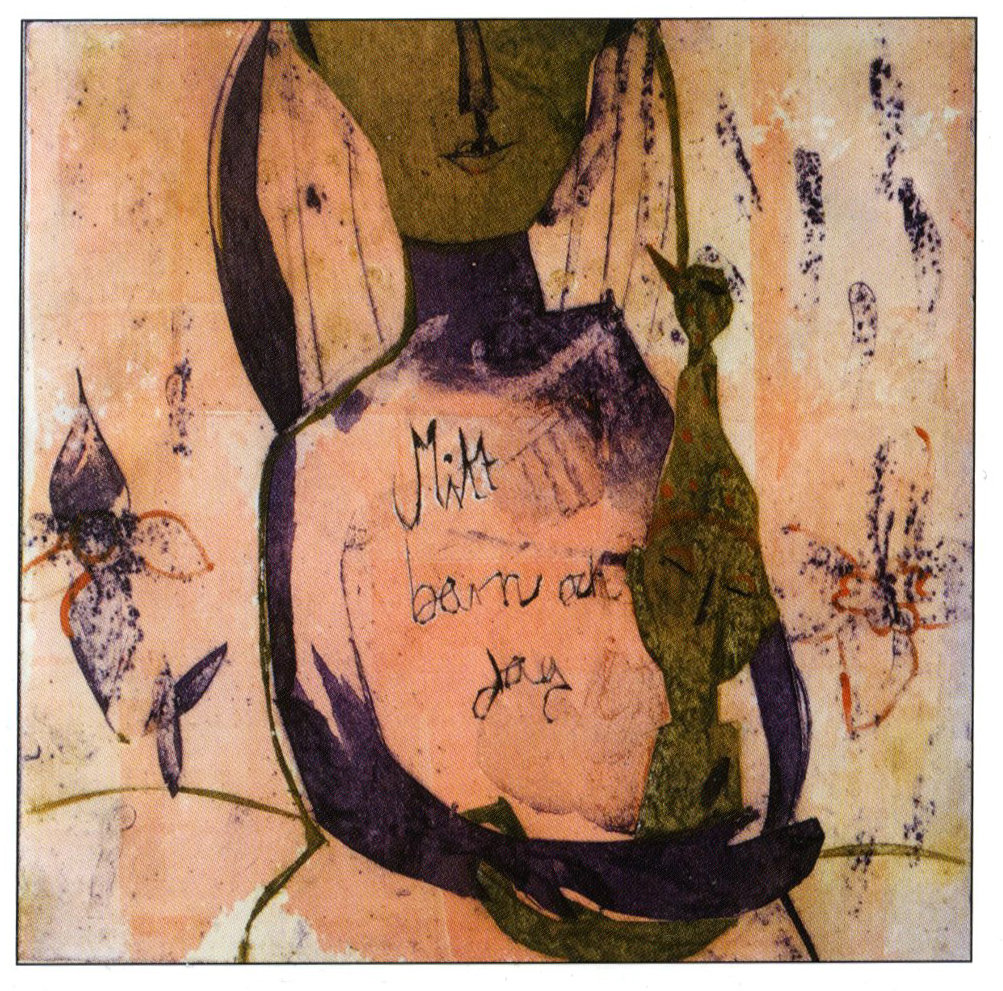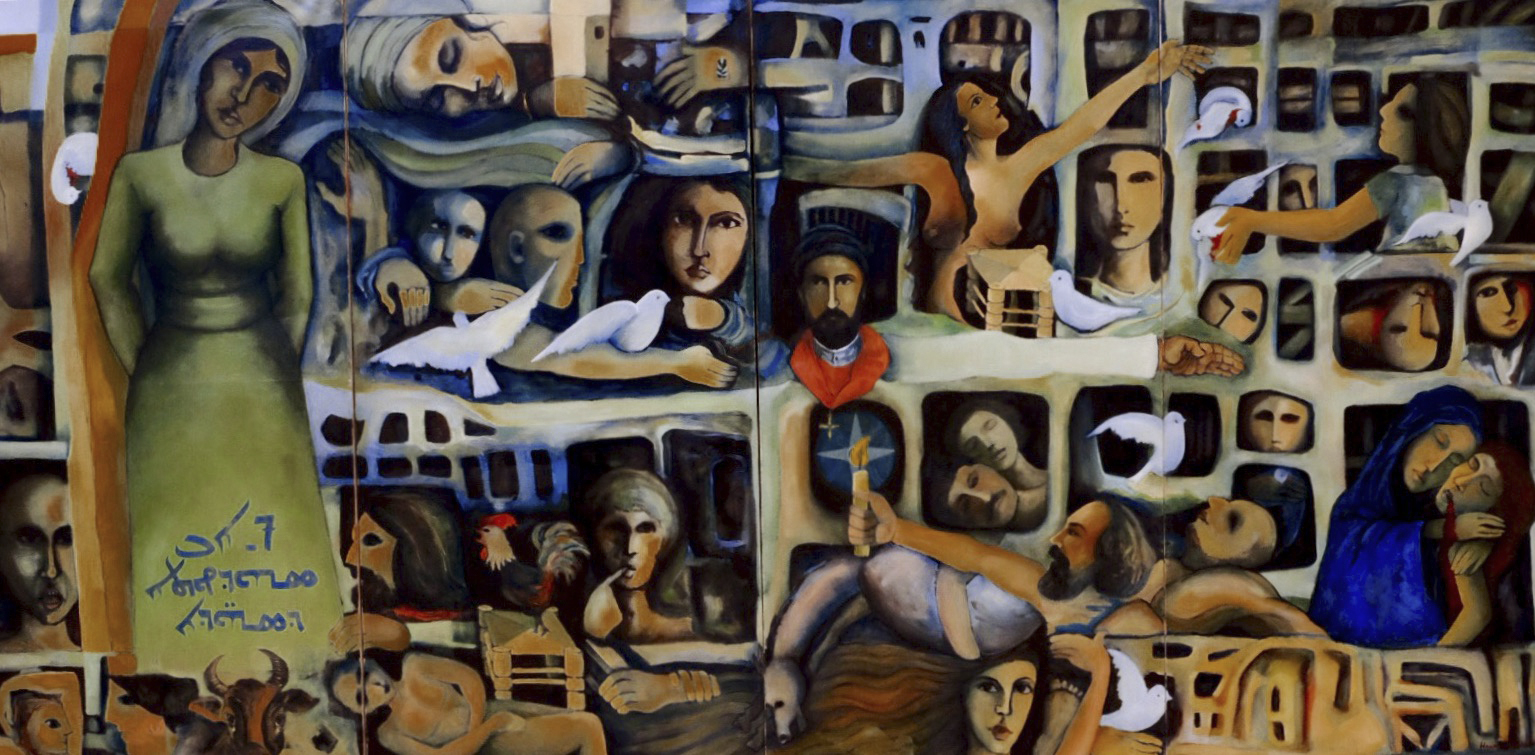


The artist Hanna Al-Haek is a well-known cultural personality for the inhabitants of Södertälje. Hanna Al-Haek came from Syria to Sweden in 1977 and has lived in Södertälje ever since. As an intellectual person, he is used to expressing himself in writing, poetry or prose and has a strong need to tell about his cultural heritage, about himself and his experiences to his fellow human beings. Nevertheless, the desire to express oneself in image and then mainly in painting is what dominates Hanna Al-Haek’s art.
The art from the years Hanna Al-Haek has lived in Sweden is now displayed at Södertälje konsthall. In the older large paintings we meet martyrs, shepherds or veiled closed and silent figures, sometimes surrounded by doves of peace or other symbol-bearing attributes. The color is dully controlled with a melancholy tone. In recent years, the images have become increasingly abstractly expressive. In the paintings you can imagine an imaginary world of urban landscapes, houses, huts and other more unidentifiable things in warm and intense bright colors.
The artist wants to evoke his memories from childhood, from the landscape, the light, the air and the events in his former homeland. In the exhibition, we get to take part in his long emotional journey from something distant and distant to a now. We get an insight into how it can be experienced to come to a new and unknown country.
Pia Thunholm, director of Södertälje konsthall 1988-99
When Hanna Al-Haek came to Södertälje in 1977 from the refugee camp in Flen, the couple Åhs – Titti and Torbjörn – took him under their wings. A refugee from Damascus in Syria. From the beginning, Hanna was seen as an exotic bird in the local artist colony – Södertälje konstnärskrets (artists organization in Södertälje). They did what they could to support him, as a newcomer to Sweden, as an artist, with various exhibitions in the municipality. Traveling exhibitions in libraries, schools, Folkets hus and decorating assignments in the form of murals both indoors and outdoors in the public sphere. Hanna turned the entire boring entrance to Folkets Hus to the assembly hall and library in Nykvarn into a wonderful sea and beach landscape.
If I remember correctly, Hanna was employed by us temporarily – at the cultural administration. Hanna’s project was to teach newly arrived Assyrian and Syrian children in Hovsjö, a suburb in Södertälje, about their history, image and mother tongue. Our then photographer Johan Fowelin, photo-documented Hanna and the children during the lessons. It was intended that the entire project would be published in book form. Unfortunately, it did not happen, probably because no publisher was interested in financing the project and the then cultural director Bengt Skoog also did not find any form of financing. When botanizing in the art gallery’s archive, we have found the material, which is shown here in the exhibition. It would be exciting to know how it went for the children who were involved in the project. They should be in their 40s and 50s today and maybe they still live in the municipality? If the project had been done today, it would not have been a problem at all to get the book printed – on demand.
I remember when Södertälje konsthalls manager then, Per Drougge commissioned Hanna, before the upcoming Sörmlandssalongen in 1985, to carry out a large work for the art gallery. The result was the painting “The Memory of the Martyrs”, a dedication to the victims massacred in the Iraqi city of Simele in 1933. The painting can be seen as a Syrian variant of Picasso’s “Guernica”. The jury members in 1985 had no problem choosing Hanna as a participant in the exhibition.
Unfortunately, it has been several years since I met Hanna due to his somewhat failing health and stamina. My memories of meetings with Hanna are absolutely positive. Always talkative and friendly. The visits to the studio at Saltskog Gård were always long and never just a “look in” visit.
A not least important part of the exhibition is Hanna’s sketchbooks. Every day he draws with black ink abstract patterns in his book. One page every day and no page is the same. The ink drawings also do not resemble anything else from Hanna’s abundant production. A fascinating collection of drawings, which we have chosen to show in a stand – we turn a page every day. Which means that you have to visit the art gallery often if you want to see more than a “diary drawing”.
Thaer Al-Haek has started an autobiography about his father. That is, Hanna tells and Thaer takes notes. 100 pages are already signed. We are waiting with great excitement for the end result. Until then, we have to make do with this somewhat simple exhibition catalog and enjoy the splendor of color in the exhibition, which runs until 30 May 2015.
I would like to extend a warm thank you to Hanna and Thaer Al-Haek whose great commitment made this exhibition possible. A warm thank you is also extended to Leif Magnusson, Göran Pettersson and Pia Thunholm for text contributions to the catalog. Thanks also to all employees who contributed to the exhibition and printed matter production.
Kristina Möller 2015-03-25
Director of Södertälje konsthall.